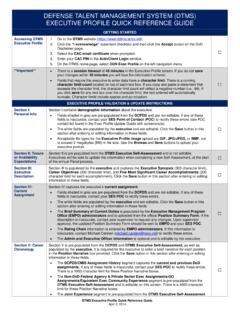Transcription of Strategic Management in Policing: The Role of the ...
1 Police Chief Magazine - View ArticleStrategic Management in Policing: The Role of the Strategic ManagerBy Kim Charrier, Strategic Manager, Phoenix Police Department, Arizona Strategic Management is a process by which managers choose a set of actions that will allow their organization to attain one or more of its long-term goals and achieve superior police executives are driving organizational change through Strategic Management -an ongoing process that seeks opportunities to enhance operational efficiencies by identifying internal issues and external influences that hinder organizational sustainability. It focuses on Management 's responsibility for implementation to create a customer-focused, high-performance learning organization.
2 Strategic managers integrate Strategic planning with other Management systems. Executives know that community policing, external and internal environments, political influences, homeland security, and new technologies are molding the profession into a more engaging system. Today, policing has evolved into a highly complex structure that requires dynamic leadership paradigms and an organization that is adaptable to a fast-paced world. To be successful in today's law enforcement environment, police executives must set the course with Strategic Management . Known as the "institutional brain" of a modern public organization, Strategic Management takes into account systems-thinking approaches while tapping into human emotions that drive organizational Strategic Management is a systems Management approach that uses active leaders in the organization to move change across organizational boundaries.
3 A small team of personnel is assembled to analyze operational functions, identify inefficiencies, review systems integration, and detect gaps in Management communications that hinder performance. In identifying organizational barriers, whether they are operational or caused by human dynamics, Strategic managers are able to recommend strategies to the police executive to improve operations and quicken transitions, while working with managers to soften human resistance to change. Although the police executive has the vision, the role of guiding the agency toward organizational renewal and change is the responsibility of all managers.
4 Major transformation in an organization cannot rest with one individual but should be guided by (1 of 6) [7/20/2010 12:53:41 PM]Police Chief Magazine - View Articleteams under the direction of Strategic managers. Police executives should scan their talent pools for command and support staff members who have the expertise, credibility, and competence to get the job done. Working with the chief executive and top managers, Strategic managers assist in expediting change by educating, training, and marketing the reasons for change to Management staff to make the vision a reality. Impediments to Change Police chiefs are expected to implement theoretical frameworks that support contemporary leadership models such as learning organizations, enlightened leadership, or the consensus model.
5 Although most police executives would agree with the argument for developing more adaptive organizations, they realize that the difficulty lies in implementation and the ability to affect the behavior and attitudes of managers to facilitate change. As leaders define the vision of the police agency, they must also identify mechanisms to drive change. One important aspect often overlooked is the potential utility of the managerial influence in the organization. Managers interpret the vision as expressed by the chief and will choose either to accept or to reject it. The managers then communicate the vision, in either a positive or a negative manner, to employees.
6 Police executives recognize the fact that first-line supervisors are responsible for implementation and ensuring policy compliance of the operational units. However, if the middle managers are not properly prepared and informed by the executive, they will fail to provide supervisors with the rationale for organizational renewal, hampering implementation by the supervisors. It is important to recognize that the rate of change is not primarily driven by operational procedures but rather by the emotional commitment to, or ownership of, the vision. Middle managers must excite change in supervisors, and this can only happen when the middle managers believe in the vision and are excited about the change.
7 To offset these challenges and to help the chief transform vision into actual practice, police executives are turning to a Strategic manager. The Strategic manager provides the chief with a person who serves as an instrument to navigate the human side of change, while using Strategic planning as the tool to drive new operational functions. In this manner the Strategic manager becomes a resource for all levels of Management to help them institute change and keep the excitement and momentum of the change moving. How a Strategic Manager Can Work for an Organization The key purpose of Strategic Management is to enhance the organization's performance by establishing operational strategies across organizational boundaries while addressing employees' resistance to change.
8 Core competencies require the Strategic manager to do any of the following: Conduct research to support and coordinate the department's Strategic plan Identify adjustments in organizational designs Identify potential barriers or gaps created by human system resistance Monitor and assess departmental progress toward Strategic planning goals Serve as the department liaison with external stakeholders in planning projects Review program research to determine applicability to departmental needs Identify proactive approaches to issues through trend analysis and predictive indicators Work to drive organizational change through marketing and educating
9 Personnel on best practice methods Assist middle managers in navigating the change process Enhance efficiency by evaluating operational systems across organizational (2 of 6) [7/20/2010 12:53:41 PM]Police Chief Magazine - View ArticleStrategic managers, working as a team with other agency managers, can help top Management drive cultural change. The configuration of the Strategic Management team is dependent upon the complexity of the change and the organization. In smaller organizations one person can serve as the Strategic manager working with supervisors to implement the vision and effect change. In larger organizations it may involve several persons in the role of Strategic managers crossing many working divisional lines and teaming with managers from various configuration used, in order to be successful the Strategic managers must have the continuous support of the police chief, a strong knowledge base, the skills to work with staff, commitment to the organization, and energy.
10 Regular and frequent communication between the chief and the Strategic Management team is essential. These Strategic Management teams will oversee quality control, strive to ensure consistency in performance, provide immediate feedback, and interact with managers at all levels. They guide the Strategic plan, working not to control but to help establish new behaviors. Why Employ Strategic Managers? John Kotter notes in his Harvard Business Review article "Why Transformation Efforts Fail" that executives may initiate a new approach or vision, but they often fail to carry the vision to the point of To institutionalize a vision it is necessary to keep in mind that employees are both suppliers and customers of change; they must participate in the change process.
















